A Never-Ending Conformational Story of the Quercetin Molecule: Quantum-Mechanical Investigation of the O3′H and O4′H Hydroxyl Groups Rotations
Abstract
1. Introduction
2. Computational Methods
3. Obtained Results and Their Discussion
4. Conclusions and Perspective for the Future Research
Author Contributions
Funding
Conflicts of Interest
References
- Cianciosi, D.; Forbes-Hernández, T.Y.; Afrin, S.; Gasparrini, M.; Reboredo-Rodriguez, P.; Manna, P.P.; Zhang, J.; Lamas, L.B.; Flórez, S.M.; Toyos, P.A.; et al. Phenolic compounds in honey and their associated health benefits: A review. Molecules 2018, 23, 2322. [Google Scholar] [CrossRef] [PubMed]
- Grytsenko, O.M.; Degtyarev, L.S.; Pilipchuck, L.B. Physico-chemical properties and electronic structure of quercetin. Farmats. Zhurn. 1992, N2, 34–38. [Google Scholar]
- Burda, S.; Oleszek, W. Antioxidant and antiradical activities of flavonoids. J. Agric. Food Chem. 2001, 49, 2774–2779. [Google Scholar] [CrossRef] [PubMed]
- Grytsenko, O.M.; Pylypchuck, L.B.; Bogdan, T.V.; Trygubenko, S.A.; Hovorun, D.M.; Maksutina, N.P. Keto-enol prototropic tautomerism of quercetin molecule: Quantum-chemical calculations. Farmats. Zhurn. 2003, N5, 62–65. [Google Scholar]
- Olejniczak, S.; Potrzebowski, M.J. Solid state NMR studies and density functional theory (DFT) calculations of conformers of quercetin. Org. Biomol. Chem. 2004, 2, 2315–2322. [Google Scholar] [CrossRef]
- Bentz, A.B. A review of quercetin: Chemistry, antioxidant properties, and bioavailability. J. Young Investig. 2009, 19, 1–14. [Google Scholar]
- Tošović, J.; Marković, S.; Dimitrić Marković, J.M.; Mojović, M.; Milenković, D. Antioxidative mechanisms in chlorogenic acid. Food Chem. 2017, 237, 390–398. [Google Scholar] [CrossRef]
- Nathiya, S.; Durga, M.; Devasena, T. Quercetin, encapsulated quercetin and its application—A review. Int. J. Pharm. Pharm. Sci. 2014, 10, 20–26. [Google Scholar]
- David, A.V.A.; Arulmoli, R.; Parasuraman, S. Overviews of biological importance of quercetin: A bioactive flavonoid. Pharmacogn. Rev. 2016, 10, 84–89. [Google Scholar]
- van Acker, S.A.; de Groot, M.J.; van den Berg, D.J.; Tromp, M.N.; Donné-Op den Kelder, G.; van der Vijgh, W.J.; Bast, A.A. A quantum chemical explanation of the antioxidant activity of flavonoids. Chem. Res. Toxicol. 1996, 9, 1305–1312. [Google Scholar] [CrossRef]
- Bogdan, T.V.; Trygubenko, S.A.; Pylypchuck, L.B.; Potyahaylo, A.L.; Samijlenko, S.P.; Hovorun, D.M. Conformational analysis of the quercetin molecule. Sci. Notes NaUKMA 2001, 19, 456–460. [Google Scholar]
- Trouillas, P.; Marsal, P.; Siri, D.; Lazzaroni, R.; Duroux, J.-C. A DFT study of the reactivity of OH groups in quercetin and taxifolin antioxidants: The specificity of the 3-OH site. Food Chem. 2006, 97, 679–688. [Google Scholar] [CrossRef]
- Marković, Z.; Amić, D.; Milenković, D.; Dimitrić-Marković, J.M.; Marković, S. Examination of the chemical behavior of the quercetin radical cation towards some bases. Phys. Chem. Chem. Phys. 2013, 15, 7370–7378. [Google Scholar] [CrossRef] [PubMed]
- Protsenko, I.O.; Hovorun, D.M. Conformational properties of quercetin: Quantum chemistry investigation. Rep. Natl. Acad. Sci. Ukr. 2014, N3, 153–157. [Google Scholar] [CrossRef]
- Vinnarasi, S.; Radhika, R.; Vijayakumar, S.; Shankar, R. Structural insights into the anti-cancer activity of quercetin on G-tetrad, mixed G-tetrad, and G-quadruplex DNA using quantum chemical and molecular dynamics simulations. J. Biomol. Struct. Dyn. 2019. [Google Scholar] [CrossRef]
- Brovarets’, O.O.; Hovorun, D.M. Conformational diversity of the quercetin molecule: A quantum-chemical view. J. Biomol. Struct. Dyn. 2019. [Google Scholar] [CrossRef]
- Brovarets’, O.O.; Hovorun, D.M. Conformational transitions of the quercetin molecule via the rotations of its rings: A comprehensive theoretical study. J. Biomol. Struct. Dyn. 2019. [Google Scholar] [CrossRef]
- Brovarets’, O.O.; Hovorun, D.M. A hidden side of the conformational mobility of the quercetin molecule caused by the rotations of the O3H, O5H and O7H hydroxyl groups. In silico scrupulous study. Symmetry 2020, 12, 230. [Google Scholar]
- Brovarets’, O.O.; Protsenko, I.O.; Hovorun, D.M. Computational design of the conformational and tautomeric variability of the quercetin molecule. In Proceedings of the 6th Young Medicinal Chemist Symposium (EFMC-YMCS 2019, Athens, Greece, 5–6 September 2019; p. 50. [Google Scholar]
- Brovarets’, O.O.; Protsenko, I.O.; Hovorun, D.M. Comprehensive analysis of the potential energy surface of the quercetin molecule. In Proceedings of the “Bioheterocycles 2019” XVIII International Conference on Heterocycles in Bioorganic Chemistry, Ghent, Belgium, 17–20 June 2019; p. 84. [Google Scholar]
- Brovarets’, O.O.; Protsenko, I.O.; Zaychenko, G. Computational modeling of the tautomeric interconversions of the quercetin molecule. In Proceedings of the International Symposium EFMC-ACSMEDI Medicinal Chemistry Frontiers 2019, MedChemFrontiers 2019, Krakow, Poland, 10–13 June 2019; p. 114. [Google Scholar]
- Filip, X.; Filip, C. Can the conformation of flexible hydroxyl groups be constrained by simple NMR crystallography approaches? The case of the quercetin solid forms. Solid State Nucl. Magn. Reson. 2015, 65, 21–28. [Google Scholar] [CrossRef]
- Filip, X.; Miclaus, M.; Martin, F.; Filip, C.; Grosu, I.G. Optimized multi-step NMR-crystallography approach for structural characterization of a stable quercetin solvate. J. Pharm. Biomed. Anal. 2017, 138, 22–28. [Google Scholar] [CrossRef]
- Tirado-Rives, J.; Jorgensen, W.L. Performance of B3LYP Density Functional Methods for a large set of organic molecules. J. Chem. Theory Comput. 2008, 4, 297–306. [Google Scholar] [CrossRef] [PubMed]
- Parr, R.G.; Yang, W. Density-Functional Theory of Atoms and Molecules; Oxford University Press: Oxford, UK, 1989. [Google Scholar]
- Lee, C.; Yang, W.; Parr, R.G. Development of the Colle-Salvetti correlation-energy formula into a functional of the electron density. Phys. Rev. B 1988, 37, 785–789. [Google Scholar] [CrossRef] [PubMed]
- Frisch, M.J.; Trucks, G.W.; Schlegel, H.B.; Scuseria, G.E.; Robb, M.A.; Cheeseman, J.R.; Scalmani, G.; Barone, V.; Mennucci, B.; Petersson, G.A.; et al. GAUSSIAN 09 (Revision B.01); Gaussian Inc.: Wallingford, CT, USA, 2010. [Google Scholar]
- Brovarets’, O.O.; Hovorun, D.M. Atomistic understanding of the C·T mismatched DNA base pair tautomerization via the DPT: QM and QTAIM computational approaches. J. Comput. Chem. 2013, 34, 2577–2590. [Google Scholar] [CrossRef] [PubMed]
- Brovarets’, O.O.; Tsiupa, K.S.; Hovorun, D.M. Non-dissociative structural transitions of the Watson-Crick and reverse Watson-Crick A∙T DNA base pairs into the Hoogsteen and reverse Hoogsteen forms. Sci. Rep. 2018, 8, 10371. [Google Scholar]
- Palafox, M.A. Molecular structure differences between the antiviral nucleoside analogue 5-iodo-2′-deoxyuridine and the natural nucleoside 2′-deoxythymidine using MP2 and DFT methods: Conformational analysis, crystal simulations, DNA pairs and possible behavior. J. Biomol. Struct. Dyn. 2014, 32, 831–851. [Google Scholar] [CrossRef]
- Hratchian, H.P.; Schlegel, H.B. Finding minima, transition states, and following reaction pathways on ab initio potential energy surfaces. In Theory and Applications of Computational Chemistry: The First 40 Years; Dykstra, C.E., Frenking, G., Kim, K.S., Scuseria, G., Eds.; Elsevier: Amsterdam, The Netherlands, 2005; pp. 195–249. [Google Scholar]
- Vásquez-Espinal, A.; Yañez, O.; Osorio, E.; Areche, C.; García-Beltrán, O.; Ruiz, L.M.; Cassels, B.K.; Tiznado, W. Theoretical study of the antioxidant activity of quercetin oxidation products. Front. Chem. 2019, 7, 818. [Google Scholar] [CrossRef]
- Frisch, M.J.; Head-Gordon, M.; Pople, J.A. Semi-direct algorithms for the MP2 energy and gradient. Chem. Phys. Lett. 1990, 166, 281–289. [Google Scholar] [CrossRef]
- Hariharan, P.C.; Pople, J.A. The influence of polarization functions on molecular orbital hydrogenation energies. Theor. Chim. Acta 1973, 28, 213–222. [Google Scholar] [CrossRef]
- Krishnan, R.; Binkley, J.S.; Seeger, R.; Pople, J.A. Self-consistent molecular orbital methods. XX. A basis set for correlated wave functions. J. Chem. Phys. 1980, 72, 650–654. [Google Scholar] [CrossRef]
- Atkins, P.W. Physical Chemistry; Oxford University Press: Oxford, UK, 1998. [Google Scholar]
- Wigner, E. Über das Überschreiten von Potentialschwellen bei chemischen Reaktionen [Crossing of potential thresholds in chemical reactions]. Zeits. Physik. Chem. 1932, B19, 203–216. [Google Scholar]
- Keith, T.A. AIMAll (Version 10.07.01). 2010. Available online: aim.tkgristmill.com (accessed on 7 January 2020).
- Matta, C.F.; Hernández-Trujillo, J. Bonding in polycyclic aromatic hydrocarbons in terms of the electron density and of electron delocalization. J. Phys. Chem. A 2003, 107, 7496–7504. [Google Scholar] [CrossRef]
- Brovarets’, O.O.; Hovorun, D.M. A new era of the prototropic tautomerism of the quercetin molecule: A QM/QTAIM computational advances. J. Biomol. Struct. Dyn. 2019. [Google Scholar] [CrossRef]
- Brovarets’, O.O.; Hovorun, D.M. Intramolecular tautomerization of the quercetin molecule due to the proton transfer: QM computational study. PLoS ONE 2019, 14, e0224762. [Google Scholar] [CrossRef] [PubMed]
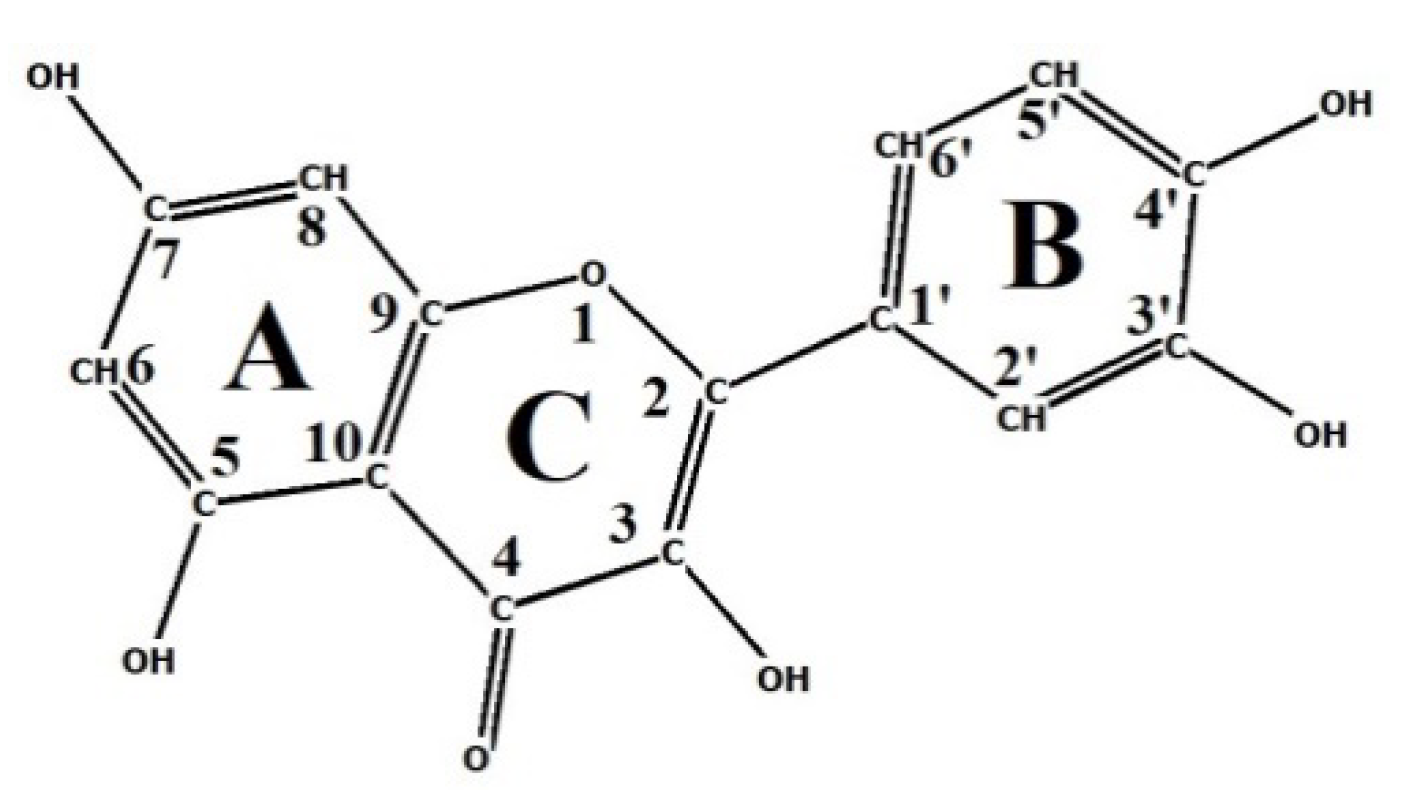
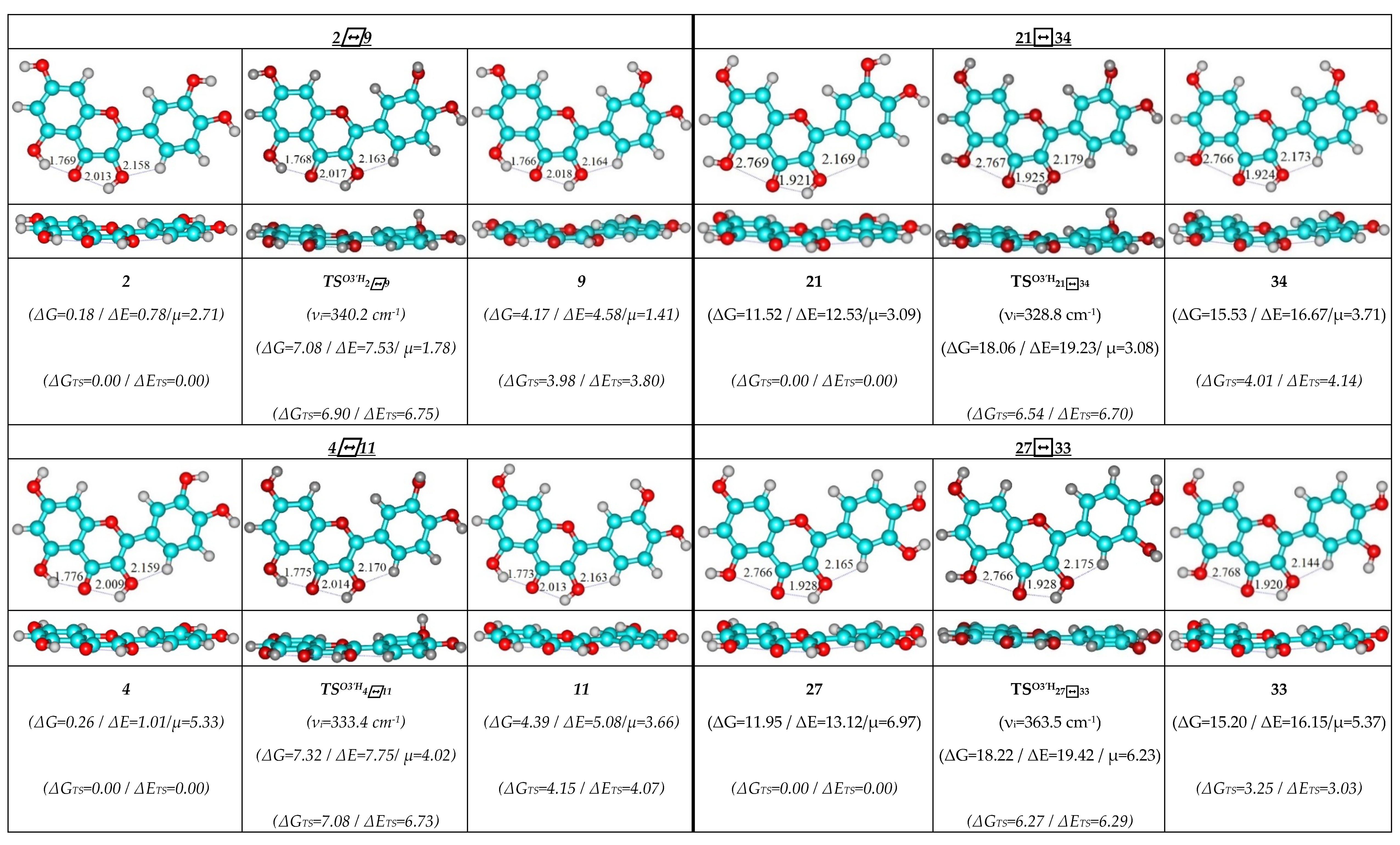
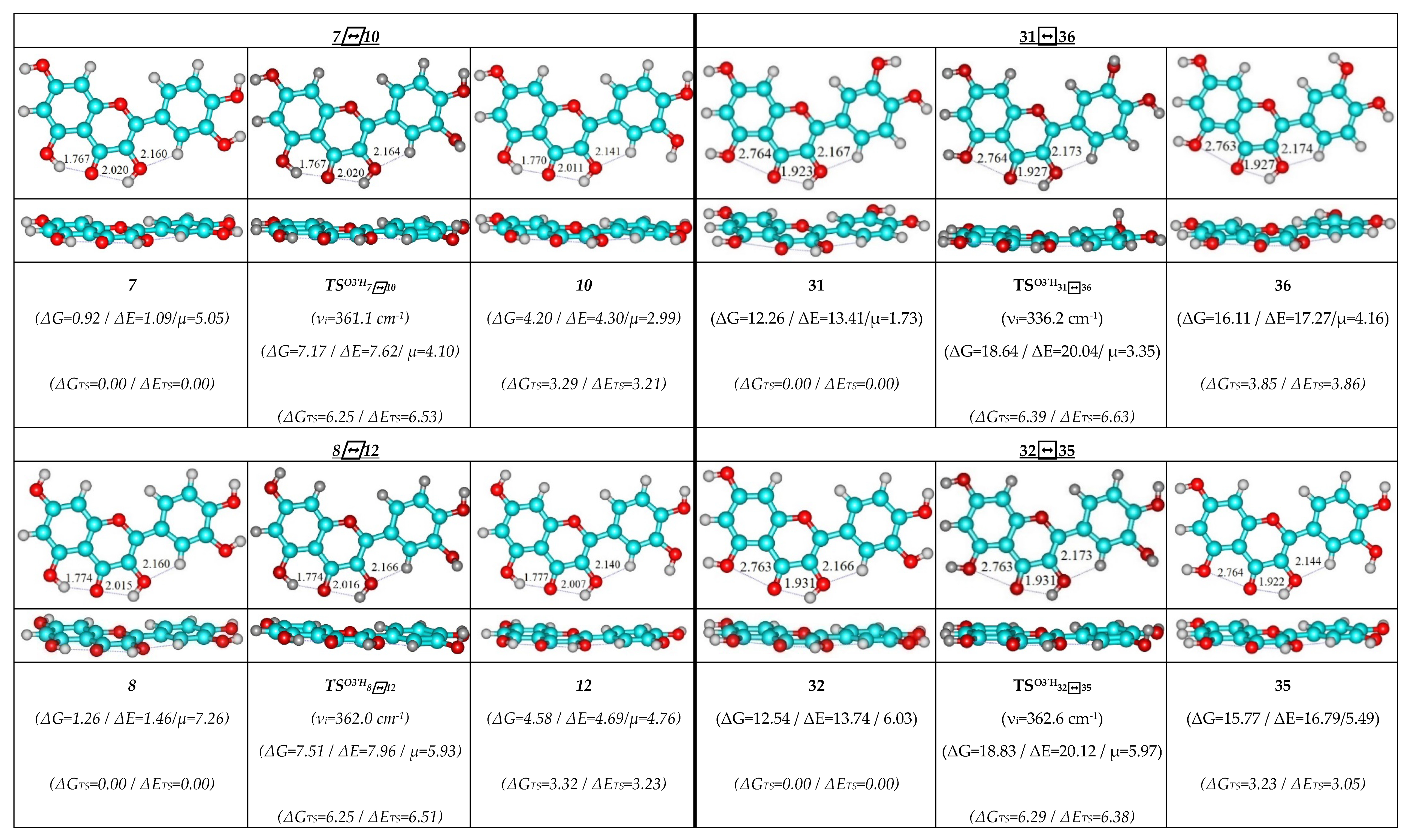
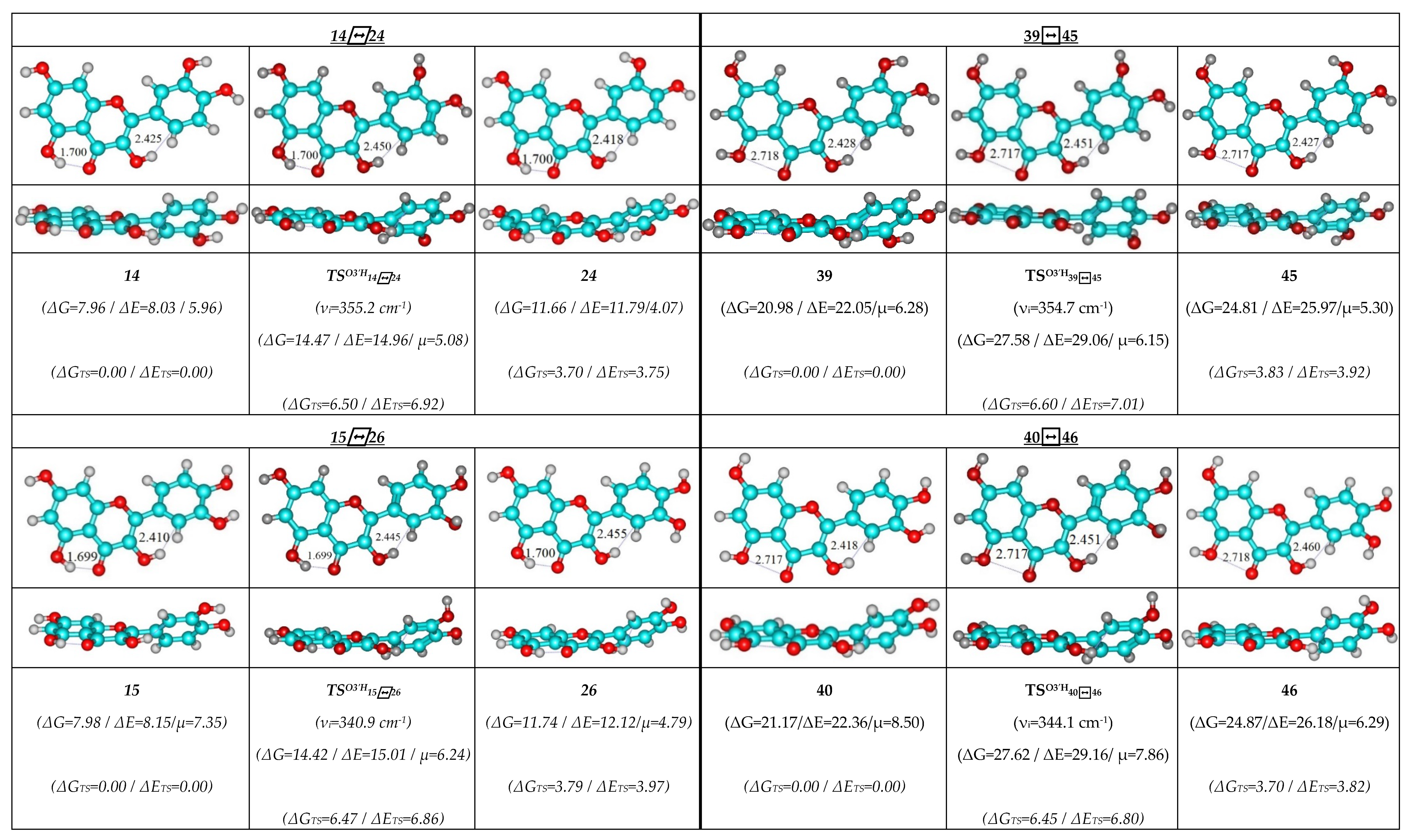

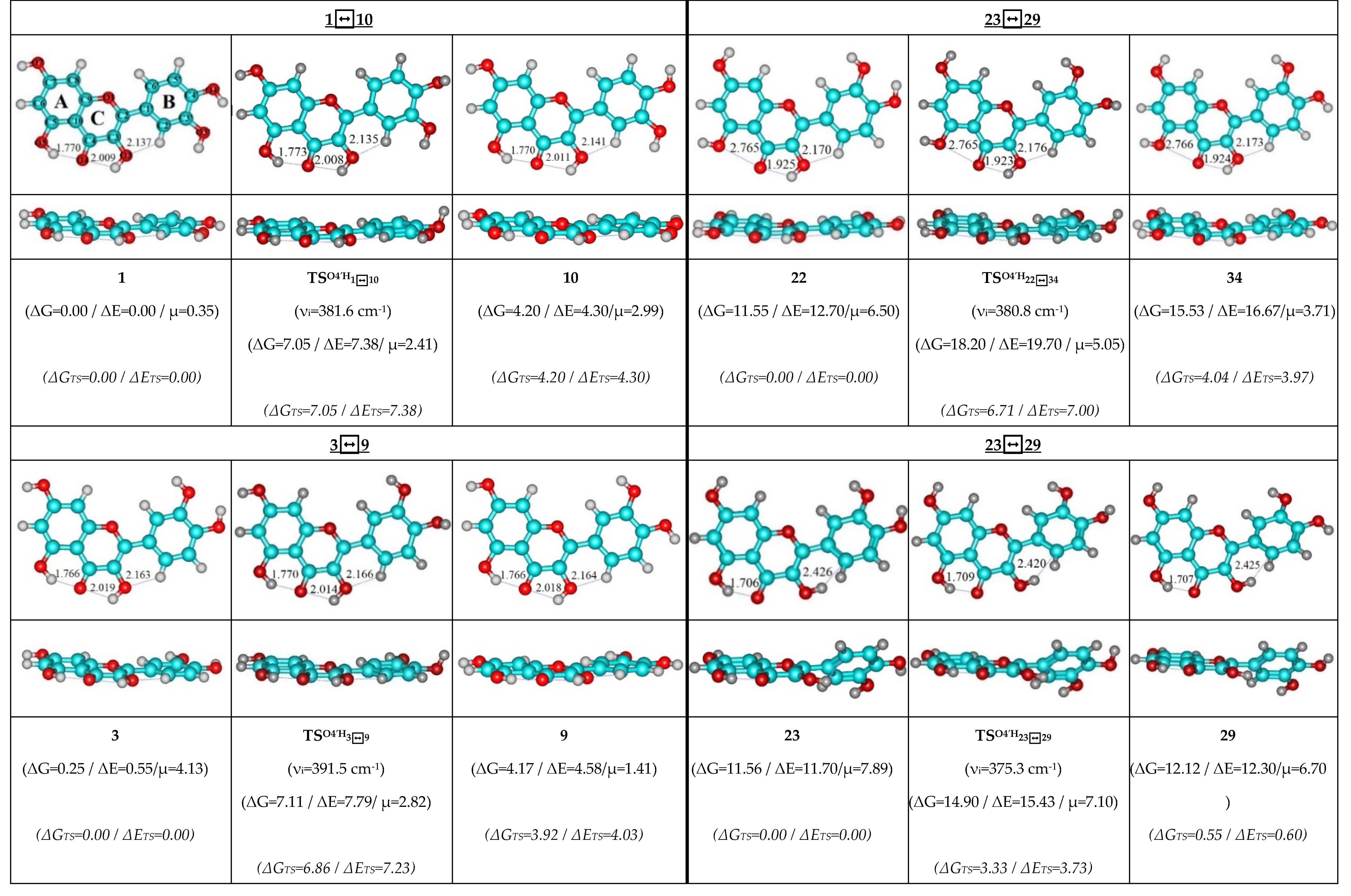
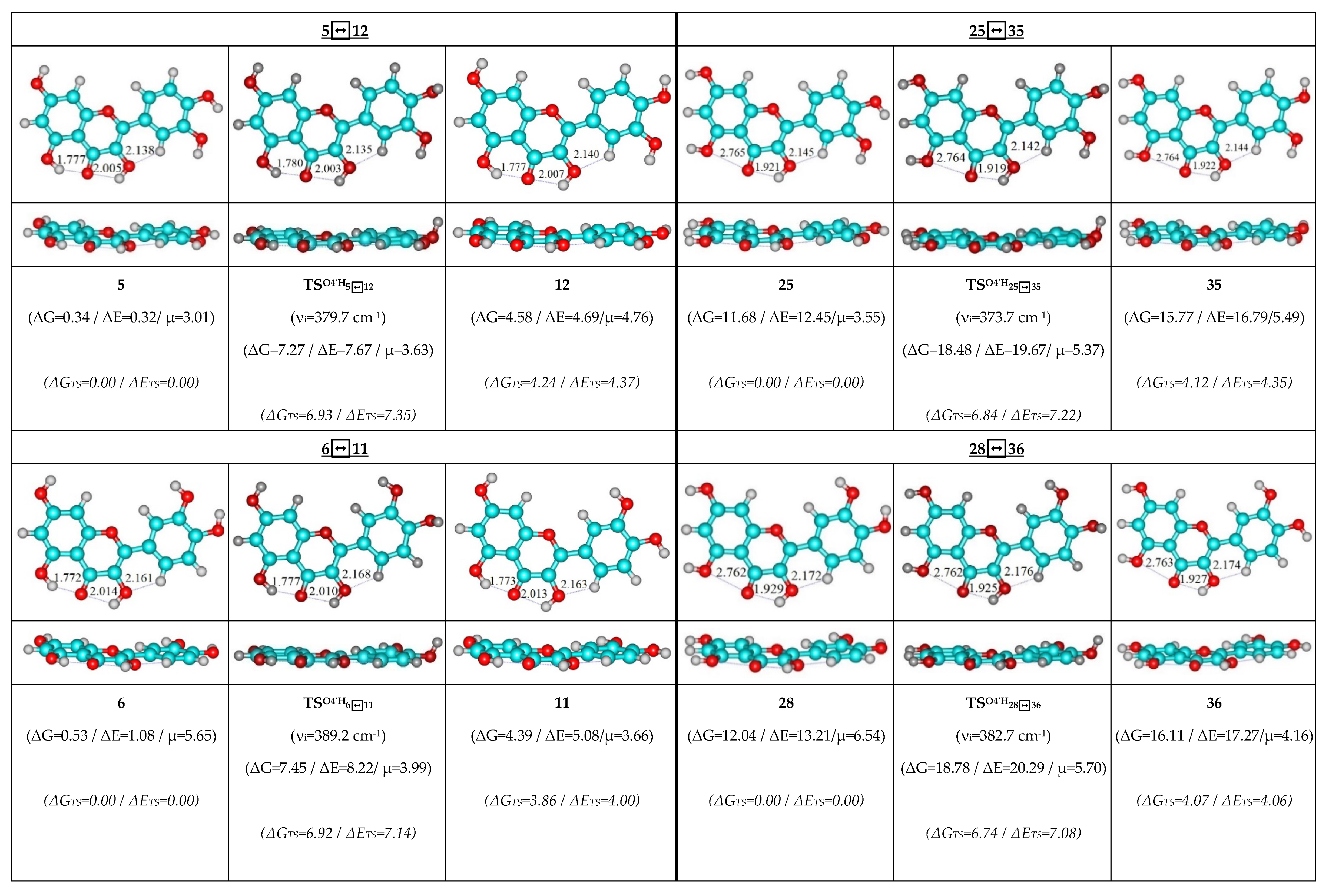
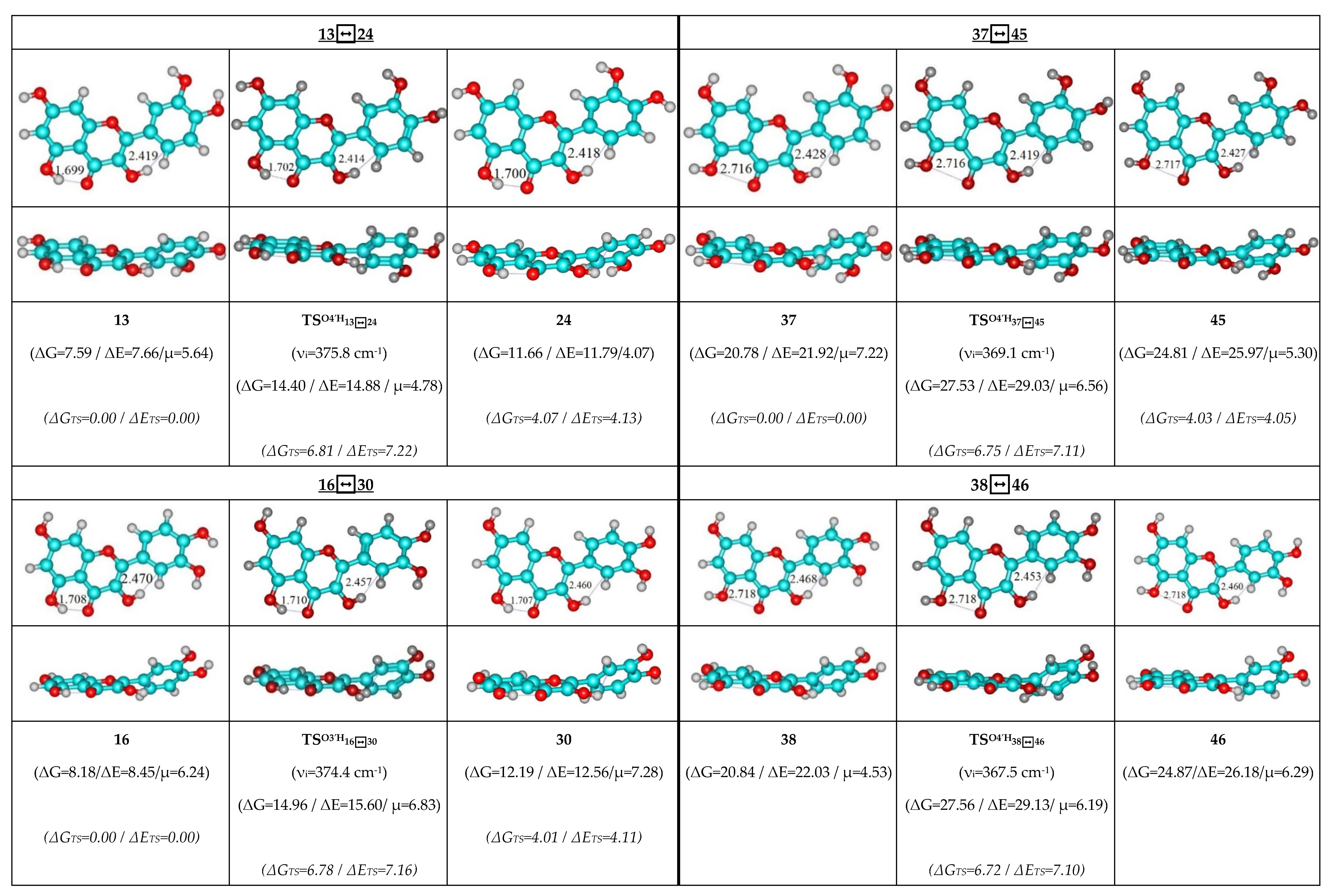
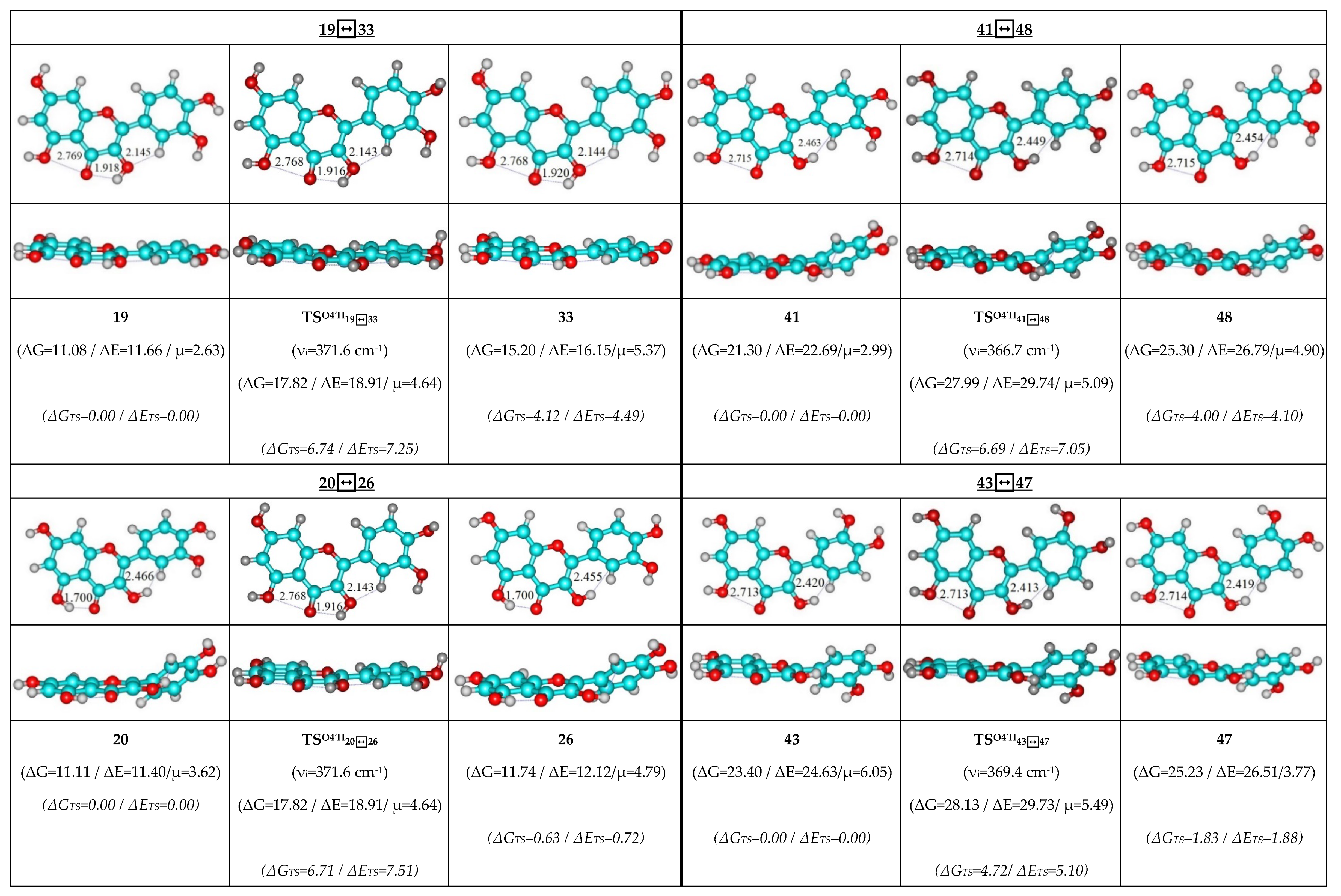
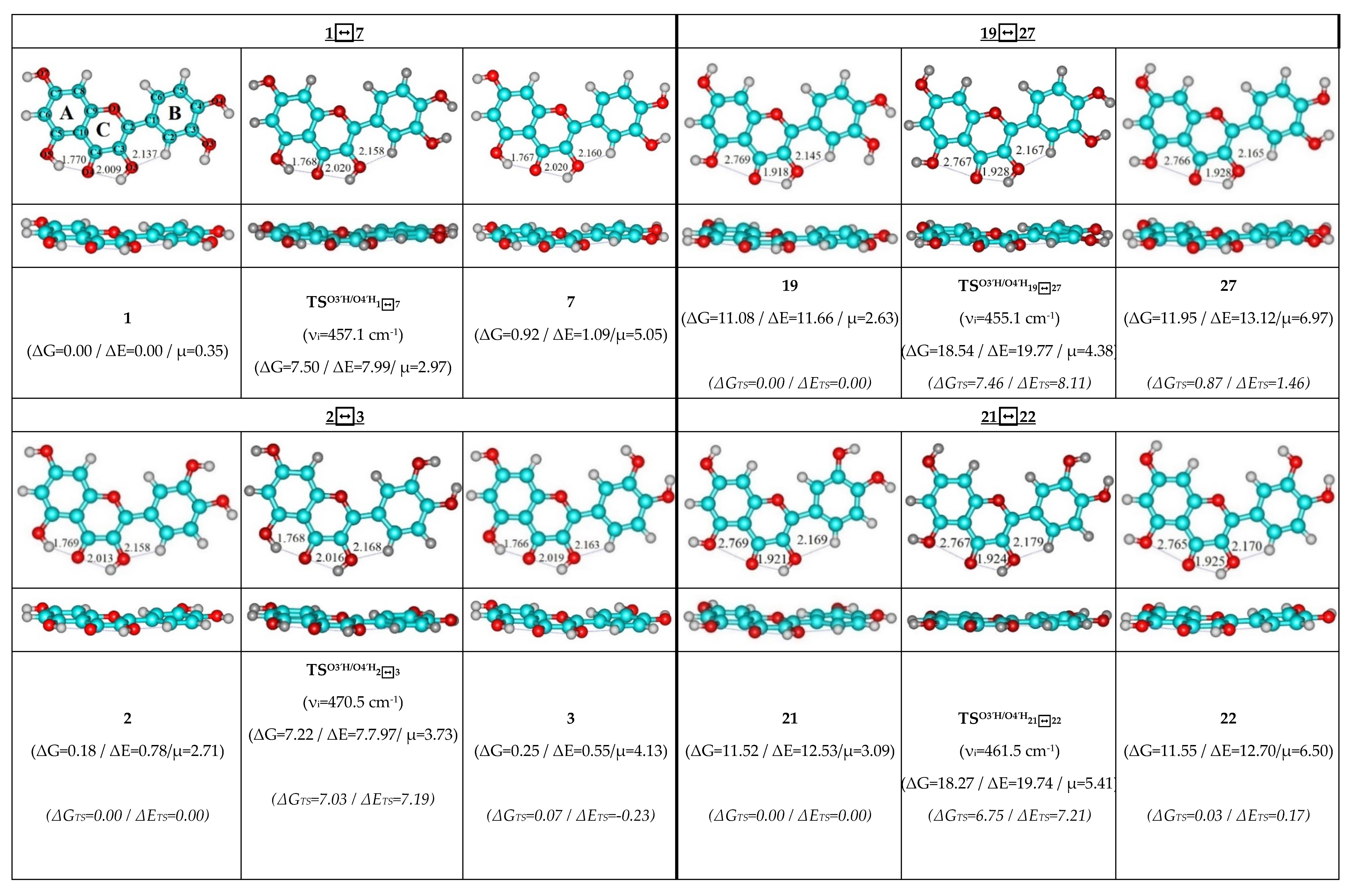
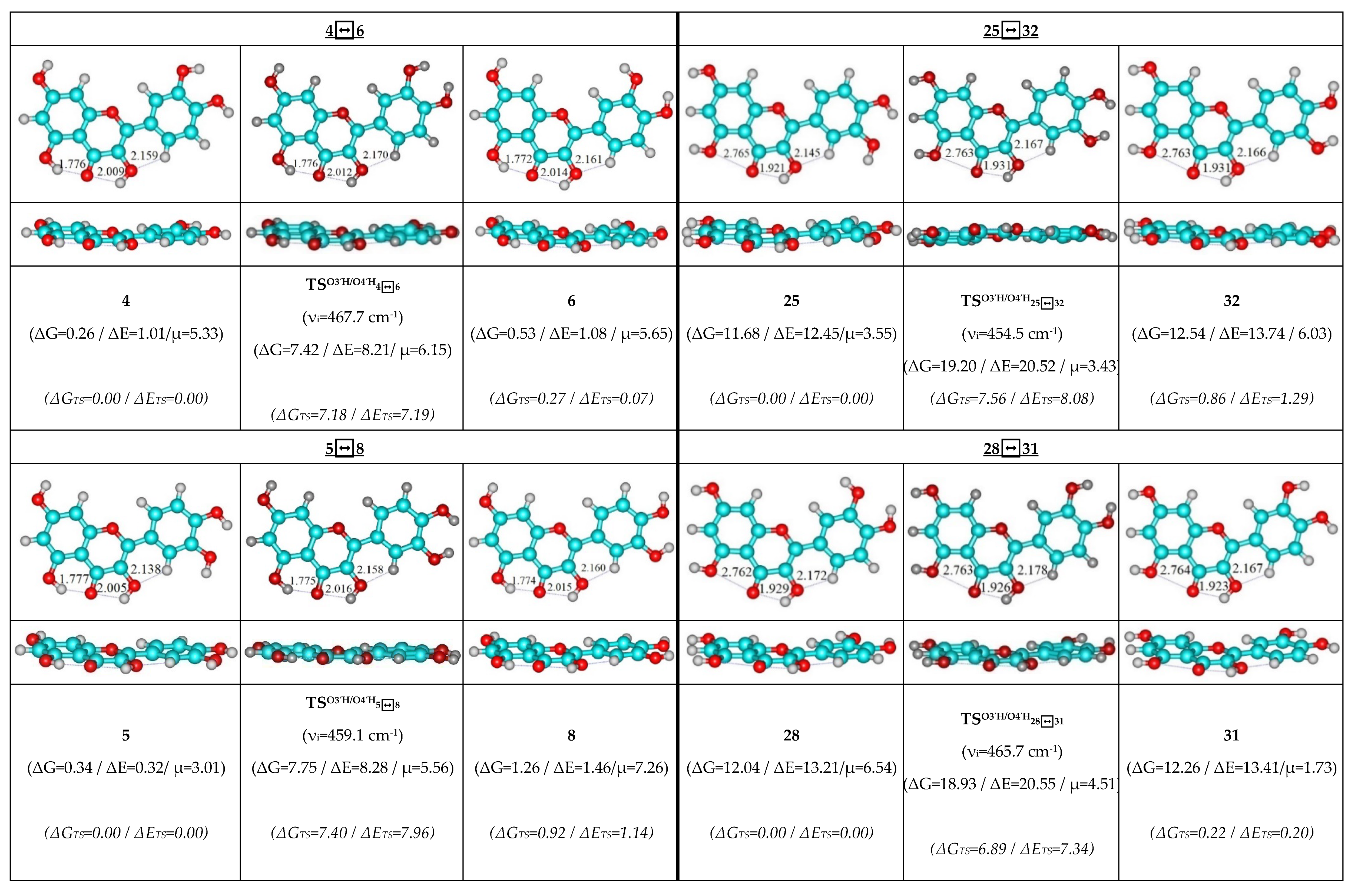
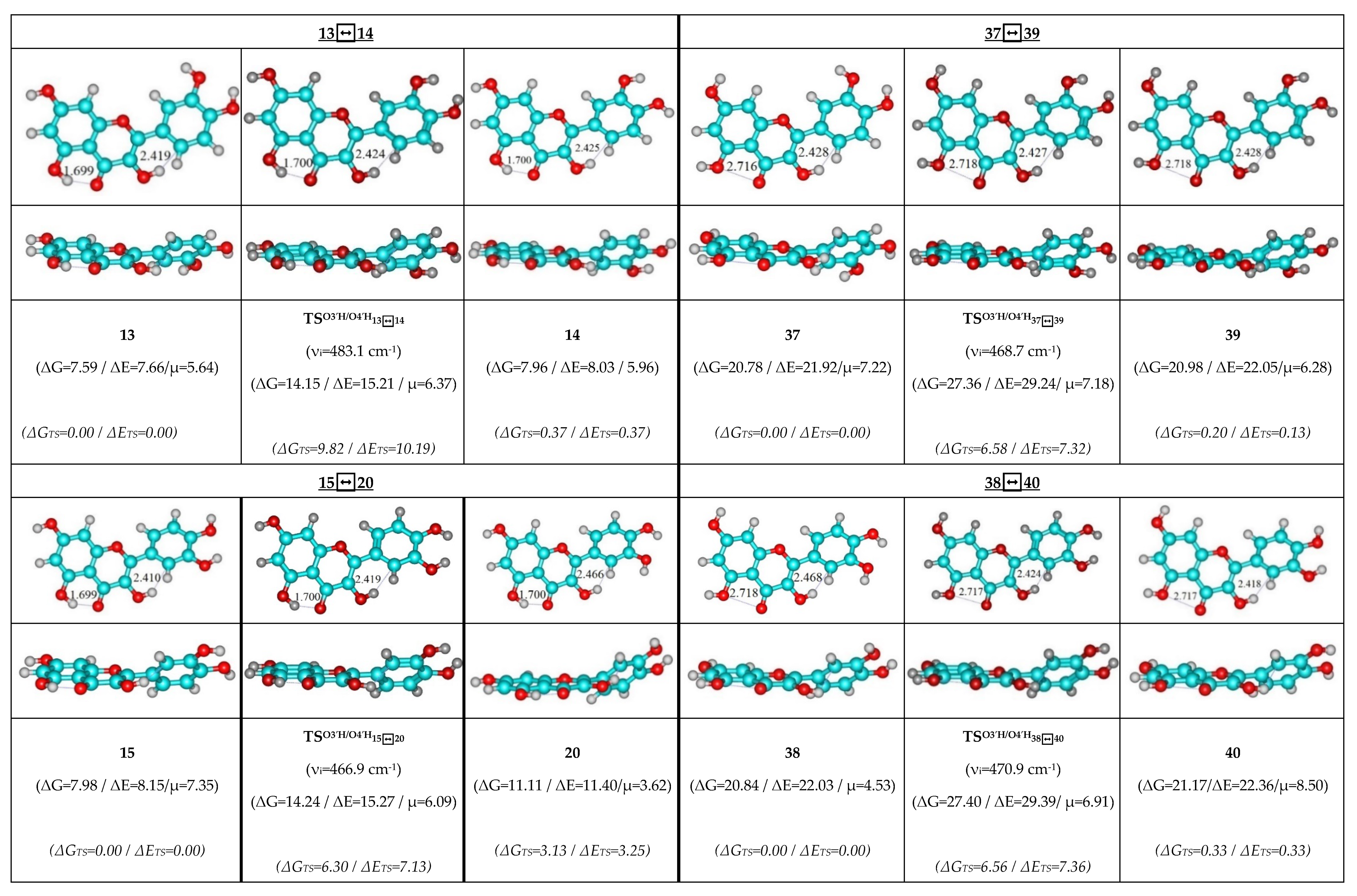
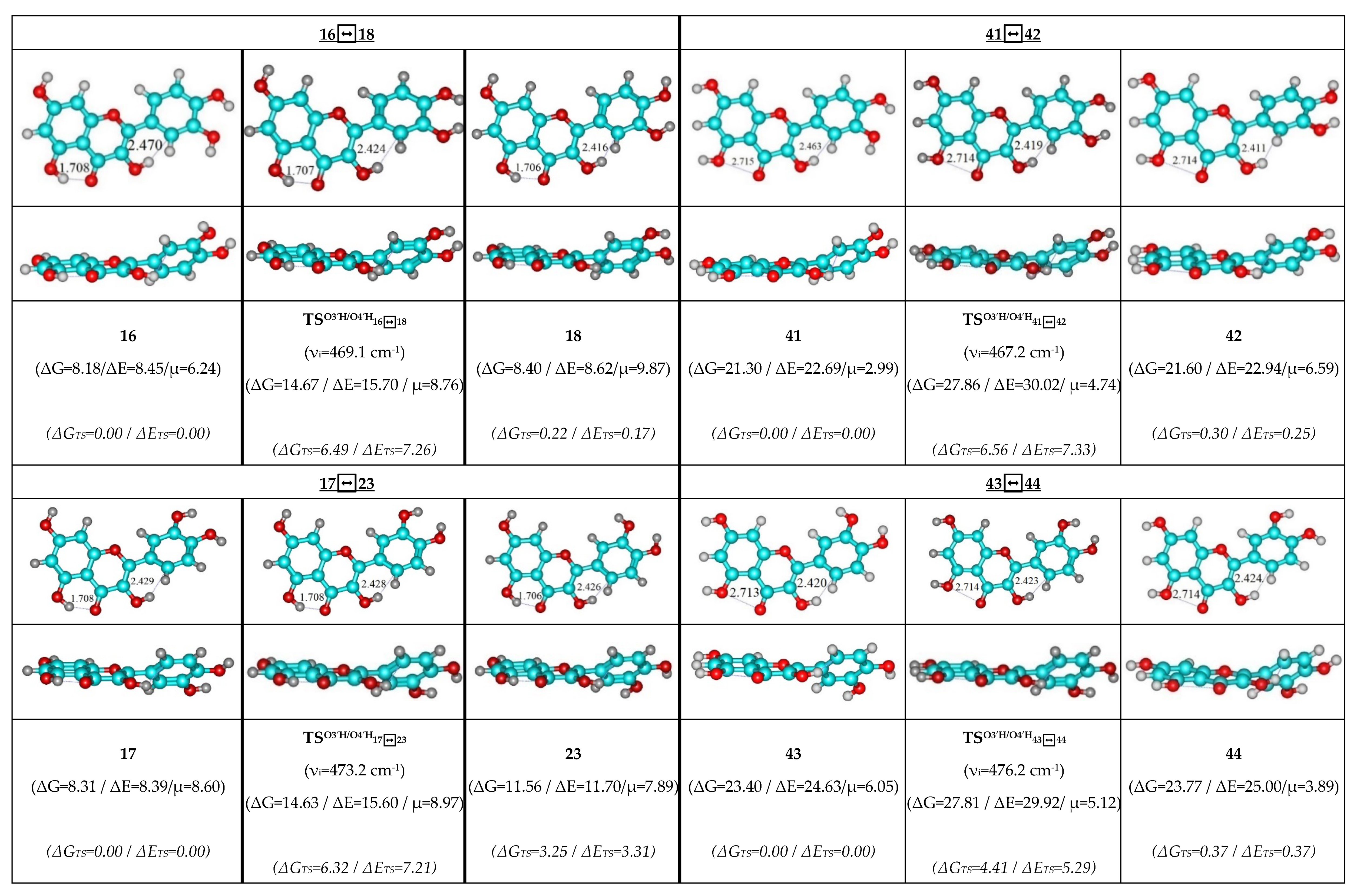
| TS of the Conformational Transition | µTS a | νi b | ∆G c | ∆E d | ∆∆GTS e | ∆∆ETS f | ∆∆G g | ∆∆E h | kf i | kr j | τ99.9% k | τ l | HO3′C3′C2′ m |
|---|---|---|---|---|---|---|---|---|---|---|---|---|---|
| TSO3′H2↔9 | 1.78 | 340.2 | 3.98 | 3.80 | 6.90 | 6.75 | 2.91 | 2.95 | 6.01∙107 | 5.01∙1010 | 1.38∙10−10 | 2.00∙10−11 | ±80.1 |
| TSO3′H4↔11 | 4.02 | 333.4 | 4.15 | 4.07 | 7.08 | 6.73 | 2.93 | 2.66 | 4.36∙107 | 4.82∙1010 | 1.43∙10−10 | 2.07∙10−11 | ±79.1 |
| TSO3′H7↔10 | 4.10 | 361.1 | 3.29 | 3.21 | 6.25 | 6.53 | 2.97 | 3.32 | 1.80∙108 | 4.62∙1010 | 1.49∙10−10 | 2.17∙10−11 | ∓82.8 |
| TSO3′H8↔12 | 5.93 | 362.0 | 3.32 | 3.23 | 6.25 | 6.51 | 2.93 | 3.28 | 1.80∙108 | 4.91∙1010 | 1.40∙10−10 | 2.04∙10−11 | ∓82.9 |
| TSO3′H14↔24 | 5.08 | 355.2 | 3.70 | 3.75 | 6.50 | 6.92 | 2.80 | 3.17 | 1.17∙108 | 6.09∙1010 | 1.13∙10−10 | 1.64∙10−11 | ±81.3 |
| TSO3′H15↔26 | 6.24 | 340.9 | 3.79 | 3.97 | 6.47 | 6.86 | 2.68 | 2.89 | 1.23∙108 | 7.44∙1010 | 9.27∙10−11 | 1.34∙10−11 | ∓79.3 |
| TSO3′H17↔29 | 7.60 | 355.6 | 3.81 | 3.91 | 6.62 | 7.05 | 2.81 | 3.15 | 9.70∙107 | 6.03∙1010 | 1.14∙10−10 | 1.66∙10−11 | ±80.6 |
| TSO3′H18↔30 | 8.65 | 343.3 | 3.79 | 3.94 | 6.50 | 6.87 | 2.71 | 2.93 | 1.17∙108 | 7.04∙1010 | 9.79∙10−11 | 1.42∙10−11 | ∓79.5 |
| TSO3′H21↔34 | 3.08 | 328.8 | 4.01 | 4.14 | 6.54 | 6.70 | 2.53 | 2.56 | 1.09∙108 | 9.51∙1010 | 7.26∙10−11 | 1.05∙10−11 | ±78.7 |
| TSO3′H27↔33 | 6.23 | 363.5 | 3.25 | 3.03 | 6.27 | 6.29 | 3.02 | 3.27 | 1.75∙108 | 4.25∙1010 | 1.62∙10−10 | 2.35∙10−11 | ∓83.3 |
| TSO3′H31↔36 | 3.35 | 336.2 | 3.85 | 3.86 | 6.39 | 6.63 | 2.54 | 2.77 | 1.42∙108 | 9.44∙1010 | 7.30∙10−11 | 1.06∙10−11 | ±79.8 |
| TSO3′H32↔35 | 5.97 | 362.6 | 3.23 | 3.05 | 6.29 | 6.38 | 3.06 | 3.33 | 1.69∙108 | 3.96∙1010 | 1.74∙10−10 | 2.53∙10−11 | ∓83.2 |
| TSO3′H39↔45 | 6.15 | 354.7 | 3.83 | 3.92 | 6.60 | 7.01 | 2.77 | 3.09 | 9.97∙107 | 6.43∙1010 | 1.07∙10−10 | 1.56∙10−11 | ±80.5 |
| TSO3′H40↔46 | 7.86 | 344.1 | 3.70 | 3.82 | 6.45 | 6.80 | 2.75 | 2.98 | 1.27∙108 | 6.60∙1010 | 1.04∙10−10 | 1.52∙10−11 | ±80.5 |
| TSO3′H42↔48 | 6.37 | 341.6 | 3.70 | 3.85 | 6.41 | 6.79 | 2.71 | 2.94 | 1.36∙108 | 7.05∙1010 | 9.78∙10−11 | 1.42∙10−11 | ∓79.6 |
| TSO3′H44↔47 | 4.47 | 353.8 | 1.46 | 1.51 | 4.23 | 4.62 | 2.77 | 3.12 | 5.47∙109 | 6.46∙1010 | 9.85∙10−11 | 1.55∙10−11 | ±81.1 |
| TS of the Conformational Transition | µTS | νi | ∆G | ∆E | ∆∆GTS | ∆∆ETS | ∆∆G | ∆∆E | kf | kr | τ99.9% | τ | HO4′C4′C5′ |
|---|---|---|---|---|---|---|---|---|---|---|---|---|---|
| TSO4′H1↔10 | 2.41 | 381.6 | 4.20 | 4.30 | 7.05 | 7.38 | 2.84 | 3.08 | 4.75∙107 | 5.77∙1010 | 1.20∙10−10 | 1.73∙10−11 | ±81.1 |
| TSO4′H3↔9 | 2.82 | 391.5 | 3.92 | 4.03 | 6.86 | 7.23 | 2.94 | 3.21 | 6.60∙107 | 4.95∙1010 | 1.39∙10−10 | 2.02∙10−11 | ∓81.9 |
| TSO4′H5↔12 | 3.63 | 379.7 | 4.24 | 4.37 | 6.93 | 7.35 | 2.69 | 2.98 | 5.80∙107 | 7.41∙1010 | 9.32E-11 | 1.35∙10−11 | ±80.8 |
| TSO4′H6↔11 | 3.99 | 389.2 | 3.86 | 4.00 | 6.92 | 7.14 | 3.07 | 3.14 | 5.90∙107 | 3.98∙1010 | 1.73∙10−10 | 2.51∙10−11 | ∓82.1 |
| TSO4′H13↔24 | 4.78 | 375.8 | 4.07 | 4.13 | 6.81 | 7.22 | 2.74 | 3.09 | 7.12∙107 | 6.89∙1010 | 1.00∙10−10 | 1.45∙10−11 | ∓80.4 |
| TSO3′H16↔30 | 6.83 | 374.4 | 4.01 | 4.11 | 6.78 | 7.16 | 2.77 | 3.04 | 7.42∙107 | 6.52∙1010 | 1.06∙10−10 | 1.53∙10−11 | ±80.7 |
| TSO4′H19↔33 | 4.64 | 371.6 | 4.12 | 4.49 | 6.74 | 7.25 | 2.62 | 2.76 | 7.98∙107 | 8.40∙1010 | 8.22∙10−11 | 1.19∙10−11 | ±80.2 |
| TSO4′H20↔26 | 4.64 | 371.6 | 0.63 | 0.72 | 6.71 | 7.51 | 6.08 | 6.79 | 8.36∙107 | 2.42∙108 | 2.12∙10−8 | 4.13∙10−9 | ±80.2 |
| TSO4′H22↔34 | 5.05 | 380.8 | 4.04 | 3.97 | 6.71 | 7.00 | 2.67 | 3.03 | 8.43∙107 | 7.74∙1010 | 8.91∙10−11 | 1.29∙10−11 | ∓81.8 |
| TSO4′H23↔29 | 7.10 | 375.3 | 0.55 | 0.60 | 3.33 | 3.73 | 2.78 | 3.13 | 2.52∙1010 | 6.41∙1010 | 7.73∙10−11 | 1.56∙10−11 | ∓80.7 |
| TSO4′H25↔35 | 5.37 | 373.7 | 4.12 | 4.35 | 6.84 | 7.22 | 2.71 | 2.88 | 6.77∙107 | 7.17∙1010 | 9.62∙10−11 | 1.39∙10−11 | ±80.5 |
| TSO4′H28↔36 | 5.70 | 382.7 | 4.07 | 4.06 | 6.74 | 7.08 | 2.67 | 3.02 | 7.99∙107 | 7.71∙1010 | 8.95∙10−11 | 1.30∙10−11 | ∓81.6 |
| TSO4′H37↔45 | 6.56 | 369.1 | 4.03 | 4.05 | 6.75 | 7.11 | 2.72 | 3.06 | 7.80∙107 | 7.09∙1010 | 9.74∙10−11 | 1.41∙10−11 | ∓80.4 |
| TSO4′H38↔46 | 6.19 | 367.5 | 4.03 | 4.16 | 6.72 | 7.10 | 2.69 | 2.95 | 8.14∙107 | 7.40∙1010 | 9.32∙10−11 | 1.35∙10−11 | ±80.2 |
| TSO4′H41↔48 | 5.09 | 366.7 | 4.00 | 4.10 | 6.69 | 7.05 | 2.69 | 2.94 | 8.64∙107 | 7.42∙1010 | 9.30∙10−11 | 1.35∙10−11 | ±80.4 |
| TSO4′H43↔47 | 5.49 | 369.4 | 1.83 | 1.88 | 4.73 | 5.10 | 2.90 | 3.22 | 2.37∙109 | 5.21∙1010 | 1.27∙10−10 | 1.92∙10−11 | ∓80.2 |
| TS of the Conformational Transition | µTS | νi | ∆G | ∆E | ∆∆GTS | ∆∆ETS | ∆∆G | ∆∆E | kf | kr | τ99.9% | τ | HO3′C3′C4′/HO4′C4′C3′ |
|---|---|---|---|---|---|---|---|---|---|---|---|---|---|
| TSO3′H/O4′H1↔7 | 2.97 | 457.1 | 0.92 | 1.09 | 7.50 | 7.99 | 6.59 | 6.90 | 2.31∙107 | 1.09∙108 | 5.23∙10−8 | 9.17∙10−9 | ±12.5/∓14.4 |
| TSO3′H/O4′H2↔3 | 3.73 | 470.5 | 0.07 | -0.23 | 7.03 | 7.19 | 6.96 | 7.42 | 5.16∙107 | 5.80∙107 | 6.30∙10−8 | 1.72∙10−8 | ±12.3/∓14.1 |
| TSO3′H/O4′H4↔6 | 6.15 | 467.7 | 0.27 | 0.07 | 7.18 | 7.19 | 6.91 | 7.12 | 4.04∙107 | 6.38∙107 | 6.63∙10−8 | 1.57∙10−8 | ±12.5/∓14.3 |
| TSO3′H/O4′H5↔8 | 5.56 | 459.1 | 0.92 | 1.14 | 7.40 | 7.96 | 6.48 | 6.82 | 2.74∙107 | 1.29∙108 | 4.41∙10−8 | 7.73∙10−9 | ±12.4/∓14.3 |
| TSO3′H/O4′H13↔14 | 6.37 | 483.1 | 0.37 | 0.37 | 6.56 | 7.55 | 6.19 | 7.18 | 1.16∙108 | 2.17∙108 | 2.07∙10−8 | 4.61∙10−9 | ±8.3/∓9.3 |
| TSO3′H/O4′H15↔20 | 6.09 | 466.9 | 3.13 | 3.25 | 6.30 | 7.13 | 3.17 | 3.88 | 1.79∙108 | 3.53∙1010 | 1.95∙10−10 | 2.83∙10−11 | ±10.0/∓12.3 |
| TSO3′H/O4′H16↔18 | 8.76 | 469.1 | 0.22 | 0.17 | 6.49 | 7.26 | 6.27 | 7.09 | 1.29∙108 | 1.88∙108 | 2.18∙10−8 | 5.31∙10−9 | ±9.1/∓11.3 |
| TSO3′H/O4′H17↔23 | 8.97 | 473.2 | 3.25 | 3.31 | 6.32 | 7.21 | 3.07 | 3.90 | 1.73∙108 | 4.19∙1010 | 1.64∙10−10 | 2.39∙10−11 | ±10.3/∓11.2 |
| TSO3′H/O4′H19↔27 | 4.38 | 455.1 | 0.87 | 1.46 | 7.46 | 8.11 | 6.59 | 6.64 | 2.50∙107 | 1.09∙108 | 5.17∙10−8 | 9.20∙10−9 | ±13.9/∓15.6 |
| TSO3′H/O4′H21↔22 | 5.41 | 461.5 | 0.03 | 0.17 | 6.75 | 7.21 | 6.72 | 7.04 | 8.30∙107 | 8.73∙107 | 4.06∙10−8 | 1.15∙10−8 | ±14.1/∓15.6 |
| TSO3′H/O4′H25↔32 | 3.43 | 454.5 | 0.86 | 1.29 | 7.56 | 8.08 | 6.70 | 6.78 | 2.11∙107 | 9.02∙107 | 6.21∙10−8 | 1.11∙10−8 | ±14.0/∓15.8 |
| TSO3′H/O4′H28↔31 | 4.51 | 465.7 | 0.22 | 0.20 | 6.89 | 7.34 | 6.67 | 7.14 | 6.56∙107 | 9.50∙107 | 4.30∙10−8 | 1.05∙10−8 | ±13.8/∓15.3 |
| TSO3′H/O4′H37↔39 | 7.18 | 468.7 | 6.58 | 7.32 | 6.58 | 7.32 | 6.38 | 7.19 | 1.11∙108 | 1.55∙108 | 2.60∙10−8 | 6.46∙10−9 | ±12.3/∓13.0 |
| TSO3′H/O4′H38↔40 | 6.91 | 470.9 | 0.33 | 0.33 | 6.56 | 7.36 | 6.23 | 7.03 | 1.14∙108 | 2.01∙108 | 2.19∙10−8 | 4.98∙10−9 | ±9.6/∓11.7 |
| TSO3′H/O4′H41↔42 | 4.74 | 467.2 | 0.30 | 0.25 | 6.56 | 7.33 | 6.26 | 7.07 | 1.15∙108 | 1.90∙108 | 2.27∙10−8 | 5.26∙10−9 | ±10.7/∓12.9 |
| TSO3′H/O4′H43↔44 | 5.12 | 476.2 | 0.37 | 0.37 | 4.41 | 5.29 | 4.04 | 4.92 | 4.37∙109 | 8.13∙109 | 5.53∙10−10 | 1.23∙10−10 | ±10.6/∓11.3 |
© 2020 by the authors. Licensee MDPI, Basel, Switzerland. This article is an open access article distributed under the terms and conditions of the Creative Commons Attribution (CC BY) license (http://creativecommons.org/licenses/by/4.0/).
Share and Cite
Brovarets’, O.O.; M. Hovorun, D. A Never-Ending Conformational Story of the Quercetin Molecule: Quantum-Mechanical Investigation of the O3′H and O4′H Hydroxyl Groups Rotations. Appl. Sci. 2020, 10, 1147. https://doi.org/10.3390/app10031147
Brovarets’ OO, M. Hovorun D. A Never-Ending Conformational Story of the Quercetin Molecule: Quantum-Mechanical Investigation of the O3′H and O4′H Hydroxyl Groups Rotations. Applied Sciences. 2020; 10(3):1147. https://doi.org/10.3390/app10031147
Chicago/Turabian StyleBrovarets’, Ol’ha O., and Dmytro M. Hovorun. 2020. "A Never-Ending Conformational Story of the Quercetin Molecule: Quantum-Mechanical Investigation of the O3′H and O4′H Hydroxyl Groups Rotations" Applied Sciences 10, no. 3: 1147. https://doi.org/10.3390/app10031147
APA StyleBrovarets’, O. O., & M. Hovorun, D. (2020). A Never-Ending Conformational Story of the Quercetin Molecule: Quantum-Mechanical Investigation of the O3′H and O4′H Hydroxyl Groups Rotations. Applied Sciences, 10(3), 1147. https://doi.org/10.3390/app10031147





